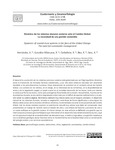Mostrar el registro sencillo del ítem
Dinámica de los sistemas dunares costeros ante el Cambio Global: la necesidad de una gestión sostenible
| dc.contributor.author | Hernández, Armand | |
| dc.contributor.author | González-Villanueva, Rita | |
| dc.contributor.author | Carballeira, Rafael | |
| dc.contributor.author | Bao, Roberto | |
| dc.contributor.author | Sáez, Alberto | |
| dc.date.accessioned | 2024-03-07T21:03:18Z | |
| dc.date.available | 2024-03-07T21:03:18Z | |
| dc.date.issued | 2023-06-20 | |
| dc.identifier.citation | Hernández, A., González-Villanueva, R., Carballeira, R., Bao, R., Sáez, A. (2023). Dinámica de los sistemas dunares costeros ante el Cambio Global: La necesidad de una gestión sostenible. Cuaternario y Geomorfología (CyG), vol. 37, núm. 1-2, p. 33-50. https://doi.org/10.17735/cyg.v37i1-2.95891 | es_ES |
| dc.identifier.issn | 2695-8589 | |
| dc.identifier.uri | http://hdl.handle.net/2183/35814 | |
| dc.description.abstract | [Resumen] El desarrollo y evolución de los sistemas arenosos costeros está gobernado por un frágil equilibrio dinámico entre la interacción de múltiples factores ambientales, y por ello estos sistemas naturales son altamente sensibles a las perturbaciones humanas. Estas alteraciones se acentúan en el contexto actual de Cambio Global. Los cambios en los vientos, en el oleaje, en la intensidad de las tormentas, en la disponibilidad de arena y en la vegetación juegan un papel crucial en el complejo desarrollo de las dunas, tanto por retener la arena que forma las dunas, como para protegerlas físicamente de la erosión. Actualmente, muchos de los ecosistemas dunares se encuentran degradados sobre todo por el déficit de aportes sedimentarios y la presión sobre la cubierta vegetal, fenómenos siempre muy relacionados con el impacto antrópico. El desarrollo natural de los sistemas dunares, incluida su vegetación, contribuye de forma significativa a amortiguar los efectos destructivos de los eventos climáticos extremos, incrementados durante el actual periodo de Cambio Global. Así, las dunas costeras suponen un patrimonio natural muy valioso que debe ser conservado. Aquí presentamos un trabajo de revisión sobre el estado del arte y una síntesis de factores y procesos de cara a un nuevo enfoque en la gestión costera. Al mismo tiempo, en este artículo se defiende una gestión que no interrumpa los procesos geomorfológicos que intervienen en el desarrollo natural del ecosistema dunar, y que son el soporte principal de su biodiversidad. Se demuestra que, a medio y largo plazo, una gestión respetuosa con la dinámica geológica dunar favorece tanto el mantenimiento de la biodiversidad como la conservación del paisaje costero y sus servicios ecosistémicos. | es_ES |
| dc.description.abstract | [Abstract] The development and evolution of coastal sandy systems is governed by a fragile dynamic balance between the interaction of multiple environmental factors, and therefore these natural systems are highly sensitive to human disturbances. These alterations are accentuated in the current context of Global Change. Changes in winds, waves, storminess, sand availability and vegetation play a crucial role in the complex development of dunes, both by trapping the sand that forms the dunes and protecting them from erosion. Currently, many of the dune ecosystems are degraded mainly due to the deficit of sediment inputs and the pressure on vegetation cover, phenomena that are always closely related to anthropogenic impact. The natural development of dune systems, including their vegetation, contributes significantly to buffering the destructive effects of extreme weather events, which have increased during the current period of Global Change. Thus, coastal dunes represent a valuable natural heritage that must be preserved. Here we present a review of the state of the art and a synthesis of factors and processes to achieve a new approach related to the coastal management. In turn, this article argues for a management that does not interrupt the geomorphological processes involved in the natural development of the dune ecosystem, which are the main support of dune biodiversity. Thus, in the medium and long term, a management that respects the geological dynamics of the dunes will promote both the maintenance of biodiversity and the conservation of the coastal landscape and its ecosystem services. | es_ES |
| dc.description.sponsorship | Este trabajo forma parte del proyecto IMPACOM (PID2019-107424RB-I00) del Ministerio de Ciencia e Innovación. AH está financiado por el Ministerio de Ciencia e Innovación mediante el programa Ramón y Cajal (RYC2020-029253-I) | es_ES |
| dc.language.iso | spa | es_ES |
| dc.publisher | Asociación Española para el Estudio del Cuaternario (AEQUA) | es_ES |
| dc.relation | info:eu-repo/grantAgreement/AEI/Plan Estatal de Investigación Científica y Técnica y de Innovación 2017-2020/PID2019-107424RB-I00/ES/IMPACTOS CLIMATICOS DE LA ERA COMUN SOBRE LOS ECOSISTEMA ACUATICOS DEL NW DE ESPAÑA/ | es_ES |
| dc.relation | info:eu-repo/grantAgreement/AEI/Plan Estatal de Investigación Científica y Técnica y de Innovación 2017-2020/RYC2020-029253-I/ES/ | es_ES |
| dc.relation.uri | https://doi.org/10.17735/cyg.v37i1-2.95891 | es_ES |
| dc.rights | Atribución-NoComercial-CompartirIgual 3.0 España | es_ES |
| dc.rights.uri | http://creativecommons.org/licenses/by-nc-sa/3.0/es/ | * |
| dc.subject | Geomorfología costera | es_ES |
| dc.subject | Sedimentos | es_ES |
| dc.subject | Clima | es_ES |
| dc.subject | Vegetación | es_ES |
| dc.subject | Ecosistemas | es_ES |
| dc.subject | Cambio Global | es_ES |
| dc.subject | Coastal geomorphology | es_ES |
| dc.subject | Sediments | es_ES |
| dc.subject | Climate | es_ES |
| dc.subject | Vegetation | es_ES |
| dc.subject | Ecosystems | es_ES |
| dc.subject | Global Change | es_ES |
| dc.title | Dinámica de los sistemas dunares costeros ante el Cambio Global: la necesidad de una gestión sostenible | es_ES |
| dc.title.alternative | Dynamics of Coastal Dune Systems in the Face of the Global Change: The Need for Sustainable Management | es_ES |
| dc.type | info:eu-repo/semantics/article | es_ES |
| dc.rights.access | info:eu-repo/semantics/openAccess | es_ES |
| UDC.journalTitle | Cuaternario y Geomorfología (CyG) | es_ES |
| UDC.volume | 37 (2023) | es_ES |
| UDC.issue | 1-2 | es_ES |
| UDC.startPage | 33 | es_ES |
| UDC.endPage | 50 | es_ES |
| dc.identifier.doi | 10.17735/cyg.v37i1-2.95891 |
Ficheros en el ítem
Este ítem aparece en la(s) siguiente(s) colección(ones)
-
GI-GRICA - Artigos [49]






